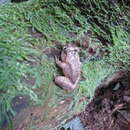tr
kırıntılardaki isimler


Astylosternus batesi és una espècie de granota que viu al Camerun, República Centreafricana, República del Congo, República Democràtica del Congo, Guinea Equatorial i Gabon.[2]
Es troba amenaçada d'extinció per la pèrdua del seu hàbitat natural.
Astylosternus batesi és una espècie de granota que viu al Camerun, República Centreafricana, República del Congo, República Democràtica del Congo, Guinea Equatorial i Gabon.
Es troba amenaçada d'extinció per la pèrdua del seu hàbitat natural.
Astylosternus batesi is a species of frog in the family Arthroleptidae.[1][2][3] It is found in Cameroon south of Sanaga River, Equatorial Guinea, Gabon, southwestern Central African Republic, the Republic of the Congo, and the extreme western Democratic Republic of the Congo (Mayombe).[1][2] The specific name batesi honours George Latimer Bates, an American naturalist.[3][4] However, its vernacular name is Benito River night frog,[1][2][3][4] apparently in reference to its type locality, Benito River in Equatorial Guinea.[2][3]
Astylosternus batesi was described based on a single specimen (holotype) that measures 70 mm (2.8 in) in snout–vent length. The head is large, much broader than it is long. The snout is broadly rounded. The eyes are large. The tympanum is very distinct, oval, and slightly smaller than the eye; a glandular fold is present above it. Skin is smooth and shiny. Fingers and toes have slightly swollen tips; no webbing is present. The terminal phalange of all but the innermost toe have a sharp, curved non-retractile bony claw (a trait shared by all species in the genus[5]). The dorsum is dark purplish brown. The venter is white. A black canthal and temporal streaks are present; a black transverse line runs between the eyes. The upper lip has two dark bars. Limbs have rather indistinct dark cross-bars.[3]
Its natural habitats are subtropical or tropical moist lowland forests, rivers, and heavily degraded former forest. It is threatened by habitat loss.
Astylosternus batesi is a species of frog in the family Arthroleptidae. It is found in Cameroon south of Sanaga River, Equatorial Guinea, Gabon, southwestern Central African Republic, the Republic of the Congo, and the extreme western Democratic Republic of the Congo (Mayombe). The specific name batesi honours George Latimer Bates, an American naturalist. However, its vernacular name is Benito River night frog, apparently in reference to its type locality, Benito River in Equatorial Guinea.
Astylosternus batesi es una especie de anfibios de la familia Arthroleptidae. Habita en Camerún, República Centroafricana, República del Congo, República Democrática del Congo, Guinea Ecuatorial y Gabón. Su hábitat natural incluye bosques tropicales o subtropicales secos y a baja altitud, ríos y zonas previamente boscosas muy degradadas. Está amenazada de extinción por la pérdida de su hábitat natural.
Astylosternus batesi es una especie de anfibios de la familia Arthroleptidae. Habita en Camerún, República Centroafricana, República del Congo, República Democrática del Congo, Guinea Ecuatorial y Gabón. Su hábitat natural incluye bosques tropicales o subtropicales secos y a baja altitud, ríos y zonas previamente boscosas muy degradadas. Está amenazada de extinción por la pérdida de su hábitat natural.
Astylosternus batesi Astylosternus generoko animalia da. Anfibioen barruko Arthroleptidae familian sailkatuta dago, Anura ordenan.
Astylosternus batesi Astylosternus generoko animalia da. Anfibioen barruko Arthroleptidae familian sailkatuta dago, Anura ordenan.
Astylosternus batesi est une espèce d'amphibiens de la famille des Arthroleptidae[1].
Cette espèce se rencontre jusqu'à 1 000 m d'altitude dans le Sud du Cameroun, en Guinée équatoriale, au Gabon, dans le sud-ouest de la Centrafrique, au Congo-Brazzaville et dans l'extrême Ouest du Congo-Kinshasa[1].
Cette espèce est nommée en l'honneur de George Latimer Bates.
Astylosternus batesi est une espèce d'amphibiens de la famille des Arthroleptidae.
Astylosternus batesi – gatunek płaza zamieszkującego rzeki i strumienie zachodniej Afryki.
Płaz ten zamieszkuje zachodnią Afrykę, posiadając pokaźny zasięg występowania. Na północy nie przekracza on kameruńskiej rzeki Sanaga, od zachodu sięga wybrzeża Atlantyku, zajmując całe terytoria Gwinei Równikowej i Gabonu, dalej część południowo-zachodniego Konga aż do Mayombe Hills położonych w zachodniej Demokratycznej Republice Konga. Od wschodu granica tego zasięgu przebiega mniej więcej przez środek państwa Kongo, zahaczając na północnym wschodzie o Republikę Środkowoafrykańską (w tym kraju płaza tego możemy spotkać jedynie przy granicy z Kamerunem)[2][3].
Siedlisko tego przedstawiciela artroleptowatych to strumienie i niewielki rzeki w nizinnych lasach, także galeriowych, położone na wysokości do 1000 m n.p.m.[2]
W środowisku wodnym, a ściślej wody płynące. Larwy zwane kijankami pływają w strumieniach o wartkim nurcie, w razie zagrożenia kryjąc się w szczelinach pod kamieniami[2].
Jest to często spotykany gatunek, jednakże liczba jego osobników maleje[2].
Gatunek posiada status LC. Główne zagrożenia dla niego to utrata siedliska spowodowana rozwojem rolnictwa i wyrębem drzew[2].
Astylosternus batesi – gatunek płaza zamieszkującego rzeki i strumienie zachodniej Afryki.
Astylosternus batesi là một loài ếch trong họ Astylosternidae. Nó được tìm thấy ở Cameroon, Cộng hòa Trung Phi, Cộng hòa Congo, Cộng hòa Dân chủ Congo, Guinea Xích Đạo, và Gabon. Các môi trường sống tự nhiên của chúng là rừng ẩm vùng đất thấp nhiệt đới hoặc cận nhiệt đới, sông, và rừng thoái hóa nghiêm trọng. Nó bị đe dọa do mất môi trường sống.
Astylosternus batesi là một loài ếch trong họ Astylosternidae. Nó được tìm thấy ở Cameroon, Cộng hòa Trung Phi, Cộng hòa Congo, Cộng hòa Dân chủ Congo, Guinea Xích Đạo, và Gabon. Các môi trường sống tự nhiên của chúng là rừng ẩm vùng đất thấp nhiệt đới hoặc cận nhiệt đới, sông, và rừng thoái hóa nghiêm trọng. Nó bị đe dọa do mất môi trường sống.